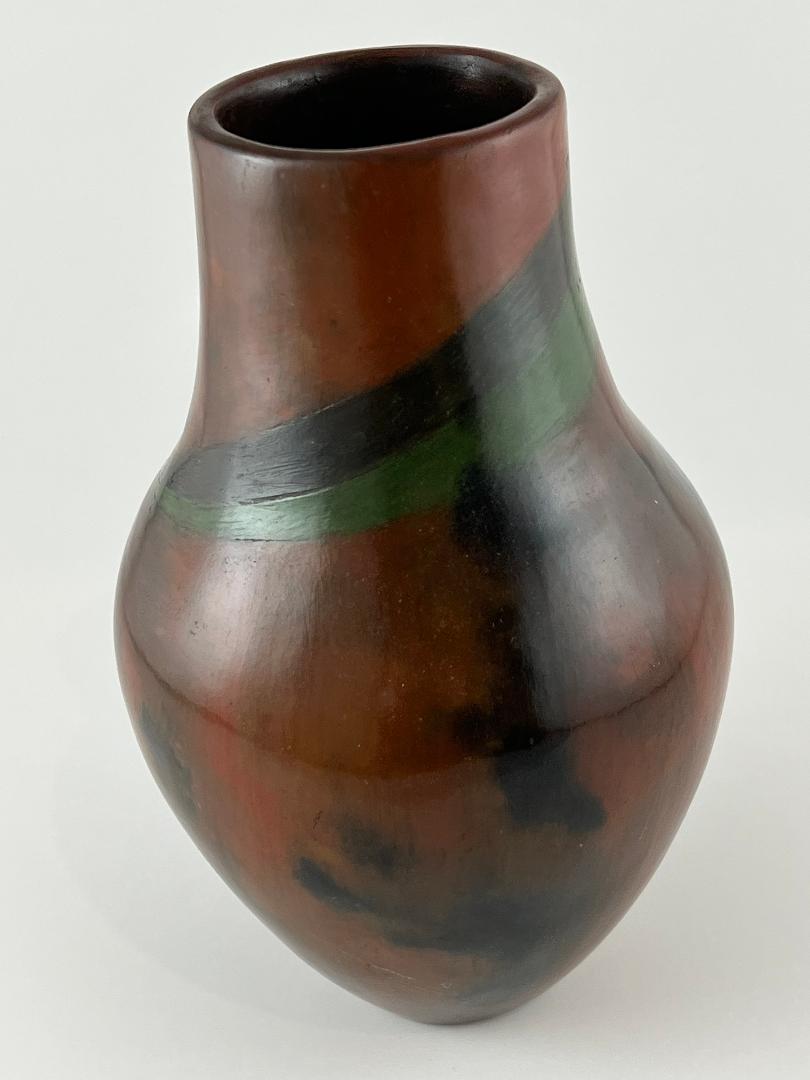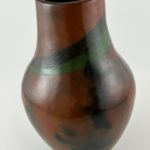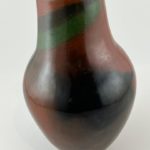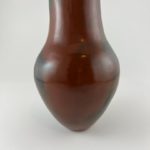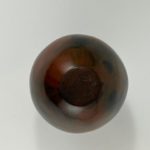A person with only a passing knowledge of southwestern Native pottery would likely and accurately guess that this pot was made by Alice Cling, so distinctive is her work. Alice’s work is traditional Navajo pottery in form and materials and because it carries the marks of its firing. Her pottery, however, has a mirror-like finish, in sharp contrast to the rough utilitarian pottery traditionally produced by her Dine (Navajo) tribe. Both traditional and innovative, Alice has created a new tradition.
Form:
The jar expands outward from a 1.5-inch base to half of its height, then turns inward to form a shoulder surmounted by a 2.25″ neck. The expansion off its small base gives the jar a visual lightness; the relatively long neck continues to draw the viewer’s eyes upward. It’s all very svelte.
Design:
As with all of Alice’s pot, much of the “design” on pot 2020-15 is the natural burn marks left by the outdoor juniper wood firing. Such marks are typical on Navajo pottery . I suspect that, like Mark Tahbo at Hopi, Alice has learned to control her firing to achieve the fire effects that she wants.
However on jar 2020-15, two 6.25-inch wedge-shaped elements provide additional decoration. They begin at the lip of the vase and slant downward together so that their points are 2.5-inches below the rim, at the point where the shoulder of the jar narrows to the neck. Alice has been forming pots for 44 years, but only recently began adding color to her pots. If you turn this vessel so that the black-over-green wedges cannot be seen, jar 2020-15 has the familiar look of most of her past work: a highly polished surface highlighted by the black smoke patches offered by the outdoor firing.
Traditionally Navajo pottery was entirely utilitarian, roughly smoothed with a dried corn cob on the outside and then covered in melted, strained, pinion pitch while hot from the fire to make it waterproof (cf. 1969-07). By finely smoothing the surfaces of her pots and repeatedly polishing many layers of pinion sap “glaze,” Alice achieves a mirror-like surface that is innovative and yet rooted in her Navajo tradition.
Charles King, from whom I bought jar 2020-15, writes of Alice that
“…her pots are considered “fine art” rather than “folk art” because of the great care she takes smoothing the surface of her pots and then throughly polishing the refined pinion pitch coating. She applies multiple coats of pitch (sometimes more than a dozen) , polishing each coat until she gets the mirror-like finish seen on (jar 2020-15). Recently she began to alter the edges and shapes of her jars, sometimes using the traditional corn cob to roughen a portion of a pot’s surface. More recently she began to add simple color elements to some pots, as with the black and green wedge shapes on (pot 2020-15).”
Discussion:
Navajo pottery has a much more recent history than pottery made by the pueblo people of the southwestern United States. A nomadic people, in the late 1300’s CE the ancestors of the Navajo migrated south from what is now Canada. When they settled in the southwest and began making pottery, it was crude and utilitarian, especially when compared to the pueblo pottery of their neighbors. By 1750 almost all Navajo pottery was was roughly sanded with a corn cob when wet, undecorated except for filets of clay (“biyo“) added around the neck of jars, and was sealed and made waterproof with the sap of the pinion tree. Harry Tschopik, Jr. (1941) offers an analysis of this tradition. Not much changed through much of the 20th century,. For details, see the catalog entry for pot 2019-07.
Alice Cling became one of the inovators, though as noted above, with her technique and not her materials. She was:
‘…born around 1946 in a Hogan at Cow Springs in the Tonalea section of Arizona. She learned how to make pottery from her mother, Rose Williams, an innovative Navajo potter. The chemistry of the clay body and the clay slip, the atmosphere in the fire, and the ash that falls onto the pots from the juniper wood combine to produce the red-orange-purple-brown-black blushes that enhance the unusual veneer of Alice’s pots. She applies a light coating of warm pitch to the warm pots after firing and burnishes that down to a distinctive low sheen. Usually her pots are totally undecorated except for the natural pigmentation from the clay and fire. Many traditional Navajo storage jars have a biyo, a beaded necklace around the shoulder of a vessel made from a textured coil of the same clay. Alice does not like to use decoration because her grandmother disapproved of using traditional designs on non-utilitarian wares. Instead, she allows the beautiful pigmentation to serve as the decoration, thus forging an original path for the works she creates.
Several of Alice’s jars were chosen by Joan Mondale for use in the vice president’s house in Washington, D.C. Alice has also taken numerous awards at Flagstaff and Santa Fe Indian fairs and powwows. Her work is unmistakably Navajo but has flair that sets it apart from any other Indian pottery being produced today (Wikipedia).”
King Galleries, from whom I purchased jar 2020-15, added that:
“Alice Cling is renown for her mastery of form in contemporary Navajo pottery. She was certainly pivotal in the evolution of Navajo pottery from folk art to fine art since the 1990s. Her perfectly balanced pottery seems to hover on a narrow base and gracefully rise to amazing heights only to be accented with a wide shoulder. Many of her works often have an asymmetric flow in design beginning from the opening, that flows gracefully with the design to the base.Alice has won numerous awards for her pottery and has been featured in books such as “Legacy of Generations”. Alice uses traditional methods of pottery construction of coil, polish, open fire, and sap coating inside and out. Each work has a beautiful rich red color with fire patterns that give the pot a very rich hand-worked art dimension. “
Thus jar 2020-15 is both firmly rooted in the utilitarian tradition of Navajo pottery but also reflects the unique modern vision and talent of its maker. There is no historical link between Alice’s work and Japanese raku pottery, but to my eye they share a commitment to simple shapes, focused effort, a mastery of skills, and a willingness to have the process of firing mark the pots. It’s all very organic and very pleasing.

